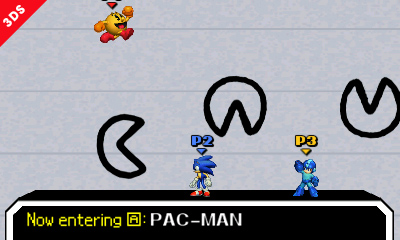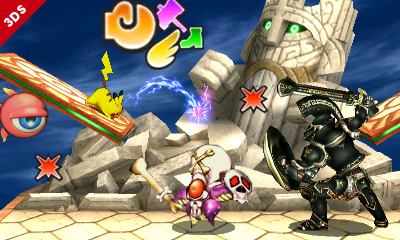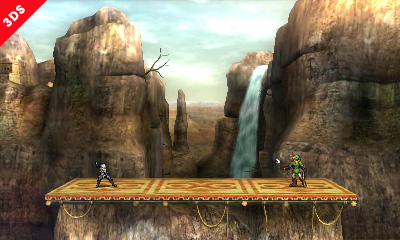The decision to bring a Super Smash Bros. game to a handheld system was one that I assessed with great concern. The franchise was one that I grew up with and put a crazy amount of hours into, so the very notion of not playing with a controller slightly scared me. The demo released before the launch of Super Smash Bros. also didn’t help quell my doubts. Once I actually sat down with the full roster and played match after match, I couldn’t have been happier to be proven wrong.
My biggest concern going in was that the controls and visuals would be neutered on a handheld system, and at first, my concerns were valid. After pushing through the pain, I got comfortable with the controls and was smashing in no time. Customizable controls definitely help in this regard. Super Smash Bros. also runs surprisingly well at a smooth 60 frames per second, and visually, it looks better than most games on the Nintendo 3DS. We’re off to a good start!
In terms of differentiating itself from previous games in the franchise, Super Smash Bros. brings a large update to the roster along with some other minor additions in terms of modes and customization. If you’re hoping for a dramatic difference in the Super Smash Bros. formula, you won’t find it here. The new roster features 51 characters, including some awesome newcomers like Pac-Man and Mega Man. Each of the characters has controls in his own unique fashion, and the number of clone characters is kept to a minimum. My only gripe is that there are a bit too many similar sword-wielding characters. Along with the Nintendo characters, three types of customizable Miis are available to swap out different move sets based on how you want to play. Altogether, this feels like the most diverse and wholesome roster in a Super Smash Bros. game.
What you do with that roster is spread out among a myriad of modes. For solo players, the Classic and All-Star modes are back to battle through a series of fights against the computer. They don’t really hold much attention and are lacking in depth compared to previous games in the series. There are also mini-games like the Home-Run Contest and Mult-Man Smash, but these again feel shallow. I was hoping for something more exhaustive such as the Event Mode in Super Smash Bros. Melee or Subspace Emissary in Super Smash Bros. Brawl, but that wasn’t the case.
The new mode exclusive for Super Smash Bros. is Smash Run. In Smash Run, you have five minutes to run around an expansive world while killing enemies to gain stat increases like speed, jumping and strength. After the time is up, you and the three other people with whom you’re playing engage in a short battle mini-game where the stats you collected are in effect. It’s intriguing at first, but for the most part, it loses its luster after a couple of runs. The resulting battle is always over very quickly, and many times, the stats you collected may not even be useful in a certain mini-game.
Throughout Smash Run and many of the other modes, there are loads of collectible trophies and other trinkets to unlock. I’ve never cared for the trophies or the flavor text that comes with them, so the incentive to continue playing these modes was nonexistent. The unlockable outfits for custom Mii characters also weren’t exciting because you can’t use Mii characters or customizable characters in competitive play online. Despite the wide array of modes for solo players, I felt rather disappointed by the lack of substance.
Most of the time spent with Super Smash Bros. will be playing just the regular Smash mode, and that’s where Super Smash Bros. has always shined. The actual fighting mechanics seem to have taken the best of both worlds from the two previous games in the series and added a nice balance of quickness and methodical movement. Both casual and hard-core players can hop in and have some fun.
For people interested in more relaxed play, all of the wild items and levels are back and more variable than ever. Getting four people together and smashing each other up with insane items, Poké balls and assist trophies is a blast. While the inventive levels can be entertaining for game play, far too many of them are overblown with gimmicks that can make things more unfair than fun. Luckily, every level can be turned into a flat, gimmick-less stage by selecting the Omega option. For hard-core players, this is a great addition.
When I feel hardened and ready for true battle, the online mode is where I head. Online play is split into two styles — For Fun and For Glory. For Fun has all of the wacky levels and items turned on for players who enjoy that. For Glory is the opposite, with every level set up as an Omega stage and items turned off. Unfortunately, the online connection is lacking. I often got connected with people from Japan or other areas in the world, which lead to drastic lag. It takes quite a while to find the right match with a solid connection. When it does happen, I’ve had some of my most exciting moments battling someone match after match and trading wins.
While Super Smash Bros. is an excellent game in its own right, I can’t help but feel like it’s a glorified demo for the real release over on the Wii U. Because it’s on a handheld device, there just isn’t enough power to make this entry feel like the next big step for the Super Smash Bros. franchise. Still, the fact that I’m able to play a great Super Smash Bros. game wherever I want is awesome. When you get down to it, the core game play is the best it has been in a long time, and I can’t imagine being bored smashing some nerds online anytime soon.



